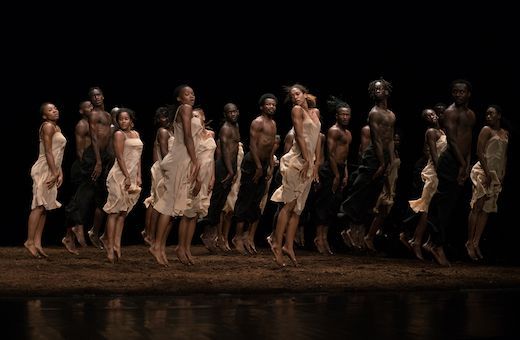Spending barely more than half-an-hour in a theatre watching dance might ordinarily be viewed as having been short-changed but if the work in question is Pina Bausch’s seminal The Rite of Spring then it’s such a feast for the senses that 37 minutes feels as if a whole evening has passed by.

There is no such thing as an ordinary performance of this coruscating interpretation of Stravinsky’s groundbreaking score. Since Bausch made the work for her own company in Wuppertal in 1975, it has migrated only to be performed by the Paris Opera Ballet and English National Ballet (one of many triumphs for the departing Tamara Rojo). This fourth iteration of the work has been to a company formed exclusively for the purpose of dancing it. Working with the Foundation dedicated to preserving Bausch’s work, Germaine Acogny – one of the most influential figures in African dance – selected 38 dancers from 14 African nations to create a purpose-built vehicle just for the Rite.
As with so much else, Covid intervened and after assembling all the dancers in Senegal the planned international tour was kyboshed by the sudden sweep of the virus. A marvellous thing came out of that hiatus since by coincidence a film crew was in Senegal making a documentary and they were able to film the ensemble performing on the beach: the resultant Dancing at Dusk became one of the internet dance sensations of 2020. Catch it if you can, it is sensational. Impromptu film aside, all plans for 2020/21 were off and Covid restrictions meant that three dancers even ended up trapped in Senegal for most of 2020!
Fast forward to the long awaited UK premiere at Sadler’s Wells and the virus still wouldn’t let go! The planned duet between 78 year-old Acogny and her younger (at 74!) fellow choreographer and dancer, Malou Airaudo, was yet another victim of contagion; and to cap it all, the stagers from the Pina Bausch Foundation, Jorge Puerta Armenta and Clémentine Deluy, performed wonders in final rehearsals to set a work usually performed by 26 or 28 dancers on just 23. Bausch’s choreography is such a geometric puzzle where every dancer’s actions impact on others that the absence of just three dancers must have necessitated significant rearrangement.
Despite all these travails, the performance was mesmerising. Bausch asked her dancers to perform as if they were about to die and that effect was dramatically simulated here. The women trembled in shivering fear, running to escape the threat of death, congregating for protection. The men – who come late to proceedings – are also largely presented in group formation but their intention is altogether more threatening. Women threw themselves desperately to wrap their legs around their partners’ shoulder and necks, their crotches erotically thrust against the men's faces. It represents a primeval plea; trading sex for protection in a ritual that will end with just one of them – the odd one out in a sinister playground game – donning the red shift dress that signifies the chosen one.
And what a performance was given by Anique Ayiboe (from Toga) as that unlucky lottery winner. She danced as if to expend every scintilla of mortal energy before the Chosen One dropped dead. The exposure of a breast in this tumultuous death dance is deliberately staged but appears to be just a natural condition of her vulnerability. At the curtain call, it was all Ayiboe could do just to remain standing.
The genius in Bausch’s work – frankly, as far as I am concerned, all of it – lies partly in the settings that she conceived with designer Ralf Borzik (and, later, Peter Pabst). In The Rite of Spring it is a matter of innovative simplicity to cover the stage with peat that is carefully raked into shape by a team of stagehands immediately prior to the performance. It’s a bonus to get in early and watch this carefully choreographed preparation which rightfully, as always, earned its own applause.
While appreciating the economic realities of life, my only regret is that the performance was given to a recorded score and not the visceral merger of live music and this coruscating dance. But frankly the sense of ritual, panic and danger would have been palpable if someone had just clapped the rhythms from the wings as Nijinsky did on that controversial night, in 1913 at the Théâtre des Champs-Élysées, when Stravinsky’s shattering score was first heard.


